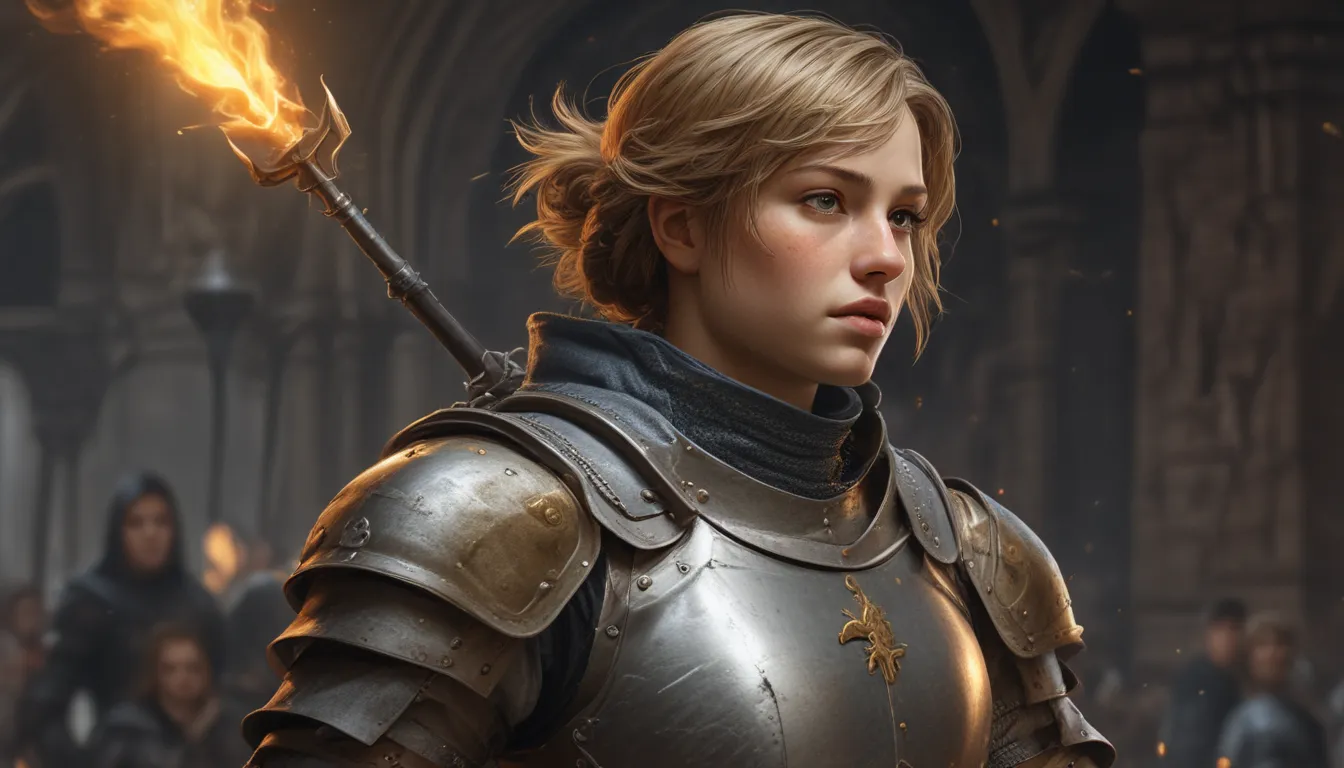The images in our articles may not match the content exactly. They are used to grab your attention, not to show the exact details in the text. The images complement the text but do not replace it.
If you’ve ever been curious about the awe-inspiring life of Joan of Arc, the brave young woman who defied expectations and changed history, then you’re in for a treat! Joan of Arc wasn’t your ordinary girl; she was a remarkable blend of visionary, warrior, and saint. From receiving divine guidance to leading French armies to victory in the midst of the Hundred Years’ War, her story is nothing short of extraordinary. But how well do you truly know her? Beyond the familiar tales of her battlefield triumphs and tragic end, there lies a treasure trove of captivating facts waiting to be discovered. Get ready to be amazed by 24 astonishing fun facts about Joan of Arc as we delve into the lesser-known aspects of this legendary heroine’s life.
Key Takeaways:
- Joan of Arc, a young peasant girl, defied gender norms and led the French army to triumph at just 17 years old, inspiring unity in France during a tumultuous period of war and division.
- Despite facing a tragic fate at the stake, Joan of Arc’s unwavering courage, visionary leadership, and enduring legacy continue to resonate with people from all walks of life, making her an emblem of hope and strength.
Unveiling the Life and Legacy of Joan of Arc
Who was Joan of Arc?
Joan of Arc, also known as Jeanne d’Arc, emerged as a national heroine of France and was later canonized as a saint by the Catholic Church. Her courageous actions and strategic leadership played a crucial role during the Lancastrian phase of the Hundred Years’ War, particularly in lifting the siege of Orléans and altering the course of the conflict in favor of Charles VII of France. Yet, beyond her military prowess, Joan’s life is filled with intriguing details that continue to captivate and inspire audiences across the globe.
Early Life and Vision:
- Birth and Upbringing: Joan was born in 1412 in Domrémy, France, amidst a backdrop of turmoil and conflict. Despite her modest origins, she would eventually carve a significant place in French history.
- Divine Visions: At the tender age of 13, Joan started experiencing visions where saints instructed her to drive the English out of France and escort Charles VII to Reims for his coronation.
The Journey of Joan:
Joan’s Call to Arms:
- Taking Up Arms: In 1429, at only 17 years old, Joan persuaded Charles VII to allow her to join the French army. Defying societal norms, she donned men’s armor and adopted a traditionally male role.
- The Triumph at Orléans: Joan’s leadership during the siege of Orléans proved pivotal in revitalizing French forces and securing a remarkable victory following multiple setbacks.
Read also: 10 Facts About World War 2 Memorial
Trial and Martyrdom:
The Tragic End:
- Arrest and Trial: Captured by Burgundian forces in 1430, Joan faced trial on charges of heresy and cross-dressing. Despite minimal evidence, she was unjustly found guilty.
- Execution: On May 30, 1431, Joan met her harrowing fate at the stake in Rouen, France, at a mere 19 years old, proclaiming the name of Jesus in her final moments.
Posthumous Recognition:
Honoring a Heroine:
- Canonization: Centuries after her passing, Joan of Arc was declared a saint by Pope Benedict XV in 1920, with her life and sacrifices commemorated by the Catholic Church and the French nation.
- Patron Saint: Revered as the patron saint of soldiers and of France, Joan’s legacy as a valiant leader and devout believer remains a wellspring of inspiration to many.
The Cultural Impact:
Echoes in Culture and Art:
- Literary and Artistic Legacy: Across centuries, Joan’s narrative has inspired myriad works of literature, art, and cinema, symbolizing courage, faith, and nationalism.
- Annual Celebrations: In France, Joan of Arc’s legacy is honored each year on May 30th, featuring parades, reenactments, and religious services in her memory.
The Intriguing Side of Joan of Arc:
Unveiling Unusual Facts:
- Divine Voices: Joan attested to hearing the voices of St. Michael, St. Catherine, and St. Margaret, whose guidance shaped her unwavering resolve.
- Absence of Military Training: Despite lacking formal military education, Joan demonstrated exceptional leadership and strategic acumen on the battlefield.
- Symbol of Unity: Joan’s endeavors were instrumental in unifying a fractured France, highlighting her enduring legacy as a unifier and national symbol.
- Shakespearean Depiction: Joan of Arc features in William Shakespeare’s play “Henry VI,” albeit from an English lens, offering contrasting perspectives.
- Modern Honors: In 2019, a French secondary school was named in Joan of Arc’s honor, underscoring her enduring impact on French culture and education.
- Cross-Faith Admiration: Joan’s courage and dedication have transcended religious boundaries, earning admiration from diverse backgrounds.
- Feminist Symbol: By adopting men’s attire and authority in the military sphere, Joan emerged as an early feminist icon challenging gender norms.
- Astronomical Tribute: A minor planet christened “4512 Jon d’Arc” in 1976 immortalizes Joan’s influence beyond historical confines.
- Pop Culture Portrayals: Joan of Arc has been featured in various media, each interpretation shedding light on different facets of her persona and historical context.
- Champion of Captives: Owing to her own imprisonment, Joan is revered as a patron saint of captives, embodying hope and resilience in adversity.
- Military Strategist: Joan’s tactical innovations and focus on morale over sheer force reshaped French military tactics for years to come.
- Universal Artistry: Artists spanning eras and styles have depicted Joan of Arc, illuminating diverse aspects of her inspiring narrative.
- Digital Representations: Joan of Arc’s legacy extends to video games, where players can engage with her historical exploits and leadership prowess.
- Symbol of Resistance: Across epochs, Joan of Arc stands as a beacon of resistance against repression, inspiring movements rooted in freedom and justice.
Embracing Joan of Arc’s Lasting Influence:
Joan of Arc’s saga is a testament to the extraordinary power of conviction and courage. From her modest beginnings to commanding armies on the battlefield, she shattered barriers, defied conventions, and etched an indelible mark on history. Her unwavering faith, unyielding resolve, and resolute spirit continue to inspire millions worldwide. Joan’s legacy imparts invaluable lessons on the tenacity of human spirit, urging us to dream fearlessly and act boldly. Her enigmatic yet revered persona serves as a poignant reminder of the enduring strength found in unwavering belief and unwavering determination. As we revisit her remarkable exploits, let’s carry forth the ethos she embodied. Joan of Arc, an exemplar of resilience and faith, illuminates the canvas of heroism in diverse hues and shades. Her saga, brimming with valor and fervor, resonates eternally with those who dare to envision the extraordinary.
Frequently Asked Questions:
Q: Why did Joan of Arc gain immense fame?
A: Joan of Arc garnered fame for her pivotal role in the Hundred Years’ War during the Lancastrian phase. Her claims of divine guidance and leadership in securing crucial victories, notably at the siege of Orléans, uplifted French morale and paved the way for subsequent triumphs.
Q: Did Joan of Arc truly hear voices?
A: Joan professed to receiving divine messages through voices, attributing them to Saint Michael, Saint Catherine, and Saint Margaret. While the authenticity of these experiences has sparked debate among historians, they fueled her righteous mission to liberate France from English rule.
Q: How did Joan of Arc meet her end?
A: Joan of Arc met a tragic demise by burning at the stake in Rouen, France, in 1431 at the tender age of 19. Years later, a posthumous retrial, convened by Pope Callixtus III, posthumously acquitted her, recognizing her innocence and martyrdom.
Q: What led to Joan of Arc’s canonization?
A: In 1920, Joan of Arc was canonized as a saint by the Roman Catholic Church in acknowledgment of her unwavering faith, pivotal role in securing victories during the Hundred Years’ War, and her ultimate sacrifice. Her steadfast commitment to her cause continues to inspire countless individuals globally.
Q: Was Joan of Arc born into a wealthy family?
A: Joan hailed from a humble background, born to Jacques d’Arc and Isabelle Romée in Domrémy, a modest village in northeastern France. Despite her modest origins and limited resources, Joan left an indelible mark on French history through her remarkable deeds.
Q: How did Joan of Arc persuade the Dauphin of France to entrust her with military leadership?
A: Joan of Arc captured the trust of Charles VII, Dauphin of France, through her unwavering conviction and possibly by revealing information that only divine intervention could have disclosed. These factors likely convinced Charles to grant her the opportunity to prove her divine mandate.
Q: What were Joan of Arc’s most notable triumphs?
A: Among Joan of Arc’s notable victories, the lifting of the siege of Orléans in 1429 stands out as a pivotal turning point in the Hundred Years’ War. Her pivotal roles in victories at Patay and in Charles VII’s coronation at Reims further solidified French dominance in the conflict.
Embarking on a Journey of Discovery:
Our dedication to delivering authoritative and engaging content forms the backbone of our mission. Every fact presented on our platform originates from real contributors like you, enriching our repository with a diverse array of insights and knowledge. Upholding the highest standards of accuracy and authenticity, our meticulous editors scrutinize each submission meticulously, ensuring that the information we convey is not only captivating but also credible. Trust in our unwavering commitment to quality and reliability as you delve into a realm of learning and exploration with us.






